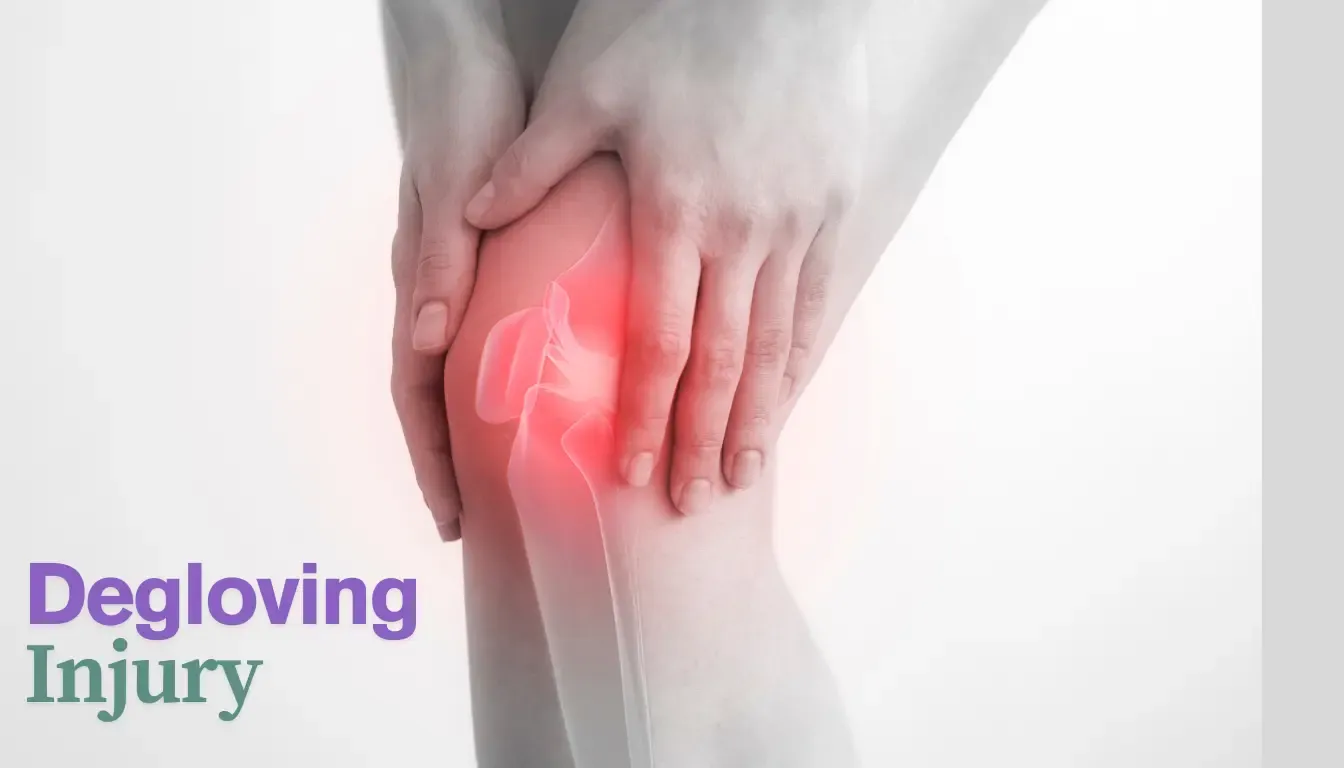A degloving injury is a very severe form of injury in which the skin and the tissue beneath are forcibly ripped away from the underlying muscle, bone, or connective tissue. This injury is a life-threatening one, creating a medical emergency that needs immediate attention. These types of degloving injuries can occur in different parts of the body, like the face, scalp, limbs, and torso. In this article, we will explore degloving injuries, types, symptoms, causes, treatment, images, and complications.
What Is a Degloving Injury?
The injury involves separation of skin and hypodermic tissue from underlying muscle and other structures. It occurs mainly from severe trauma situations resulting from car accidents, sports injuries, or unusual industrial hazards. The injury depends on the severity of the impact.
Types of Degloving Injuries
There are mainly two types of degloving injuries:
Open Degloving
In this type of degloving injury, the skin gets completely ripped off, exposing the muscles, bones, and tendons beneath. This injury is highly visible and results in a large amount of bleeding. Open degloving injury results from severe trauma such as harsh car accidents, industrial accidents, crush injuries, etc.
Closed Degloving
In this type of degloving injury, the injury occurs under the skin and involves separation of soft tissues from the underlying structures, with no signs of external wound. This type of injury is also termed as Morel-Lavallee lesion and is mainly caused due to falls, sports injury, or blunt force trauma, with no instant visibility, which makes it even tougher to diagnose.
Degloving Symptoms
The symptoms of the degloving injury may vary depending on the type and the extent of severity. The common symptoms of degloving injury include:
- Ripped skin in the case of open degloving
- Extreme pain followed by swelling
- Severe bleeding in open degloving
- Exposed bones, tendons, and muscles
- Skin discoloration and bruising
- Sensory loss or tingling in the area of injury
- Difficult to move the injured body part
- Infection involving pus, fever, and if treatment is not done
What leads to degloving injuries?
Degloving injuries result from severe impact trauma that creates separation of skin from underlying tissues. It occurs mainly due to:
- Vehicle accidents – body parts get caught in windows or doors
- Industrial hazards – during industrial and construction setup
- Animal bites – the skin is ripped off by animals like horses or dogs
- Sports injury – severe impact contact sports such as skiing, cycling
- A fall from a significant height
Degloving Injury Diagnosis
A healthcare expert will proceed with the examination of degloving injuries through:
- Physical Test – it includes assessment of injury, its severity, location, and whether there is any infection caused.
- Imaging Test – X-rays are used to identify the fracture, and MRI/CT scans for examination of damages caused within soft tissues and internal wounds in case of closed degloving injuries.
How can degloving injuries be treated?
The treatment of degloving injury depends on the extent of injury, and it should be immediately availed. The basic approach involves:
Emergency Care
- Pressure application to control severe bleeding.
- Disinfection and proper cleaning of the wound to prevent infection.
- Providing painkiller medications and shifting to a nearby hospital.
Surgical Treatment
- The portion of degloved skin is attached back following surgical procedures if there is any possibility of reattachment.
- When there is no possibility of skin reattachment, then skin grafts from another body part may be used to cover the exposed area.
- Flap surgery is performed, which involves the shifting of tissue from a nearby body part to cover the injured portion.
- When the tissue is severely damaged in extreme cases, amputation is the only option left.
Care Post-Surgery: Prevention and Rehabilitation
- Use of antibiotics to prevent infection.
- Adapting physical therapy for mobility restoration and proper functionality.
- Management of pain and wound care to enhance the healing process.
- Physiological support from family members and friends as these types of injuries result in high emotional distress.
Complications Involved in Degloving Injuries
If degloving injuries are left untreated or refrain from immediate treatment, it can result in severe complications such as:
- The exposed tissues may lead to bacteria entering the wound, causing severe infection.
- If an excessive amount of blood loss occurs, it may lead to tissue necrosis.
- Development of permanent scars or numbness in the affected area may require reconstructive surgery.
- If nerve damage occurs, it may lead to the situation of paralysis.
- An individual may undergo emotional trauma, leading to depression, anxiety, etc.
- If the injury is intense, amputation may be compulsory.
Degloving Injuries: Prevention
It is not possible to prevent degloving injuries, but preventive measures can surely be adopted to reduce the risk of injury:
- Wear protective gear while riding a vehicle, or even during sports activities like skiing.
- Use of appropriate safety equipment to avoid industrial hazards.
- Follow traffic rules and avoid risky behaviour.
- Ensure that the machinery to be operated has proper safety features.
Final Words
Degloving injuries are intense and may be life-threatening. It is essential to provide immediate medical attention to minimize the risk. Early diagnosis of the injury, access to modern surgical care, and post-injury rehabilitation play a vital role in the healing process. Adopting preventive measures and awareness can help reduce the risk of these severe injuries.
FAQs
Are degloving injuries self-healing?
No, rather, they require immediate treatment and often surgical measures for proper healing.
What is the recovery period of a degloving injury?
The recovery time varies depending on the intensity of injury, which may be from weeks to months, depending on the care taken.
Is a degloving injury fatal?
If left untreated, severe injury resulting in a high amount of blood loss can be life-threatening.
Is it possible to prevent degloving injury?
No, degloving injuries cannot be prevented, but wearing proper safety gear and employing safety protocols can reduce the risk.













